Hizen Nagoya Castle
-Huge and dignified headquarter looking at straight-
Overview
Name: Hizen Nagoya castle (Hizen Nagoya-jo)
Alias: Nagoya-jo (Nagoya castle)
Place: Chinzei-cho Karatsu city, Saga
Location: 33.53106425861987, 129.87097845610867
Type: Hill Castle
Built: 1592
Remaining remnants: Stone walls and moats
Title: 100 famous Japanese castles
Hizen Nagoya castle (肥前名護屋城, formal name of this castle is Nagoya castle but to distinguish from Nagoya castle at Aichi prefecture, it is often called as Hizen Nagoya castle) is located at hill in the center of Higashi Matsuura peninsula, about 10 kilometer north of Karatsu city.
Higashi Matsuura peninsula is a one of five kilometer wide and 10 kilometer long faces Tsushima straight, and locates at the edge of linear connection route between Japan and Korea through Tsushima island and Iki island. In addition to this, this peninsula consists of rias coast, and numerous gulfs guarded by small islands were ideal for the anchoring place for ships.
In medieval era, north coast area of Hizen province (Saga prefecture and Nagasaki prefecture) was held by Matsuura party. Matsuura party was a coalition of local retainers stem from 11th century, and engaged in commercial and maritime activity around East China Sea and Tsushima straight. At the time of Genko, sequential invasions of Chinese Yuan dynasty and Koryo kingdom of Korea to Japan in the latter half of 13th century, Matsuura army activated at the naval battle against intruders.
In Muromachi era, Hata clan grew to the leader of east part along with Hirado clan which became the leader of west part of Matsuura peninsula. Hata clan resided at Kishidake castle (Saga prefecture) and exercised their power around East Matsuura peninsula, but later they became weakened because of internal conflicts and had to subordinate to surrounding strong warlords such as Ryuzoji clan or Shimazu clan.
At the time of Kyushu campaign by central ruler Hideyoshi Toyotomi (1537-1598), Kishi clan once surrendered to Hideyoshi and once was forgiven, but later was expelled and ruined. Instead of Hata clan, Hirotaka Terasawa (1563-1633), general of Hideyoshi, became the lord of this area.
Originally there was a small castle of Matsuura party at the current place of Hizen Nagoya castle. In 1590, Hideyoshi Toyotomi defeated Hojo clan which had most part of Kanto region, and united all over the Japan. Hideyoshi further planned foreign expansion, and decided to build a new castle as his headquarter at this place. At the time of Odawara campaign against Hojo clan, Hideyoshi already built Ishigakiyama castle (Kanagawa prefecture), a modern one wholly protected by stone walls as his headquarter, and Hojo clan which saw the power and strong will of Hideyoshi finally surrendered. Hideyoshi might aim to do the same thing on a large scale to foreign counties across the ocean.
The planning of the castle was made by Yoshitaka Kuroda (1546-1604, famous as Kanbe), a famous military staff of Hideyoshi, and actual construction were performed by local lords of Kyushu Island under the command of Kiyomasa Kato (1562-1611) and Masanori Fukushima (1561-1624), two young commanders under Hideyoshi. The construction was started from the autumn of 1591, and competed in the spring of 1592.
Hizen Nagoya castle spread along with a jackknife shaped hill of 50 meter high from the hillside, which spread to southeast ward and south west ward from the center point. Central area is a square shaped area of 100 meter length, and places at the highest point of the hill in the east half of the hill.
At the north edge of the central area, where is the crossing point of two ridges, there was a five story seven floor main tower built on the 20 meter long square basement. Third area located at the east of central area directly guarded the entrance into central area, and a 150 meter long and 20 meter wide slope continued from the main gate of the castle at the hillside to the central area along with east side wall of third area.
At the west part of the hill, there spread the secondary area and Danjo-maru area of 200 meter long and 100 meter width. At the west edge of the hill a magnificent “Masugata” style (combination of two gates and buffer area) backside gate was built, same style as font gate. Several areas such as Yugeki-maru or Mizunote cover the north slope of the hill, and private residence of Hideyoshi and his concubine Yodogimi (1569-1615) named as Yamazato-maru and huge complex style outer gate were placed at the north east side of the hill.
Outer area including well and kitchen existed at the east of the hill, and wide dry moat surrounded east half of the castle. Total size of Hizen Nagoya castle reached to 1,000 meter long and 500 meter width, and whole part of the castle were protected by stone walls. Total length of stone wall might exceed three kilometer.
As it was not expected to fight with the enemy using this castle, military element is not so strong for Hizen Nagoya castle. Stone walls are not so high and steep compared with other large castle built at the beginning of Edo era such as Osaka castle or Kumamoto castle, and number of turrets is limited considering its huge size.
Even though folded and protected by stone walls, a long and gentle wide slope continues from the outside to the central area. Layers of flat and wide terrace emphasized the authority of Hideyoshi and might look closer to Chinese palace such as Forbidden City, instead of Japanese castle. Hideyoshi liked such kind of style, and Osaka castle at the time of Hideyoshi is said to have the same elements.
Hideyoshi gathered all of the lords to this area, irrespective to actual participation to military action. Many lords with over total 100,000 soldiers stayed all over the peninsula surrounding Hizen Nagoya castle. As the stay continued long time, each lord had a permanent base guarded by stone walls. Especially the base of Toshiie Maeda (1539-1599), large and close lord to Hideyoshi stayed just next to Hizen Nagoya castle, had a magnificent entrance protected by tall stone wall, equivalent to Hizen Nagoya castle.
Hideyoshi commanded foreign operation from this castle, but without any achievement died in ill in 1598. Subsequent to the death of Hideyoshi, a conflict between Ieyasu Tokugawa (1543-1616), the largest lord under Toyotomi government and Mitsunari Ishida (1560-1600), a chief administrative staff of Hideyoshi occurred. Hirotaka Terasawa supported Ieyasu Tokugawa who won against Mitsunari, and was given Amakusa area (Kumamoto prefecture) as a reward.
Under the order of Edo Shogunate established by Ieyasu, Hizen Nagoya castle was abolished and destructed to erase the impression of Hideyoshi and his foreign expedition. It was too large to demolish, but basement of main tower was thoroughly destructed as a symbol of the castle. Stone of the castle were used to build Karatsu castle (Saga prefecture)at 10 kilometer south of this castle.
Furthermore, 30 years later, a large rebellion of local pheasantsnamed “Shimabara no Ran” (incident of Shimabara) occurred at Shimabara area and Amakusa area in 1637, because of strict politics of Itakura clan at Shimabara area and Terasawa clan at Amakusa area, in addition to suppression to Christians. Edo Shogunate subjugated this rebellion with certain damage, and to prevent recurrence of such rebellion Edo Shogunate again ordered to break the ruin of Hizen Nagoya castle again.
To remove the defensive function, corner of the wall were demolished, and top of the wall were tear down to let the attacker walk up the wall. Several gates were filled with sands, to destroy the function of traffic control. But certain part of stone walls still remained two time destruction.
Subsequent to Meiji revolution, the site of the castle became a historical site and has been improved. As a ruler Hideyoshi built three huge castles, it means Osaka castle (Osaka prefecture), Fushimi castle (Kyoto prefecture) and this Hizen Nagoya castle. But Osaka castle was totally renovated by Edo Shogunate and lost the original shape of Toyotomi era, and Fushimi castle was now off limit because it is used as a grave of Emperor Meiji.
Even though certainly broken, Hizen Nagoya castle is valuable as an only remnant of huge castle keeps its original atmosphere built by Hideyoshi. Being built by unfortunate circumstance and located at distant place, it might be regarded as one of the best castle ruins in Japan itself and, and long continuing stone walls consist of rough stones are worth for visiting.
40 minutes bus ride from Showa bus Karatsu bus center at Karatsu city. 30 minutes drive via Route 204 from Karatsu city.
Ishigakiyama Castle -Master of sieging castle-
Osaka Castle -Symbol of unification of Japan-
Fushimi Castle -Ironical result of secure castle-
Karatsu Castle -Picturesque castle at the coast-
Type: Hill Castle
Built: 1592
Remaining remnants: Stone walls and moats
Title: 100 famous Japanese castles
Brief History
Hizen Nagoya castle (肥前名護屋城, formal name of this castle is Nagoya castle but to distinguish from Nagoya castle at Aichi prefecture, it is often called as Hizen Nagoya castle) is located at hill in the center of Higashi Matsuura peninsula, about 10 kilometer north of Karatsu city.
Higashi Matsuura peninsula is a one of five kilometer wide and 10 kilometer long faces Tsushima straight, and locates at the edge of linear connection route between Japan and Korea through Tsushima island and Iki island. In addition to this, this peninsula consists of rias coast, and numerous gulfs guarded by small islands were ideal for the anchoring place for ships.
History becore construction
In medieval era, north coast area of Hizen province (Saga prefecture and Nagasaki prefecture) was held by Matsuura party. Matsuura party was a coalition of local retainers stem from 11th century, and engaged in commercial and maritime activity around East China Sea and Tsushima straight. At the time of Genko, sequential invasions of Chinese Yuan dynasty and Koryo kingdom of Korea to Japan in the latter half of 13th century, Matsuura army activated at the naval battle against intruders.
In Muromachi era, Hata clan grew to the leader of east part along with Hirado clan which became the leader of west part of Matsuura peninsula. Hata clan resided at Kishidake castle (Saga prefecture) and exercised their power around East Matsuura peninsula, but later they became weakened because of internal conflicts and had to subordinate to surrounding strong warlords such as Ryuzoji clan or Shimazu clan.
At the time of Kyushu campaign by central ruler Hideyoshi Toyotomi (1537-1598), Kishi clan once surrendered to Hideyoshi and once was forgiven, but later was expelled and ruined. Instead of Hata clan, Hirotaka Terasawa (1563-1633), general of Hideyoshi, became the lord of this area.
Construction of huge headquarter
Originally there was a small castle of Matsuura party at the current place of Hizen Nagoya castle. In 1590, Hideyoshi Toyotomi defeated Hojo clan which had most part of Kanto region, and united all over the Japan. Hideyoshi further planned foreign expansion, and decided to build a new castle as his headquarter at this place. At the time of Odawara campaign against Hojo clan, Hideyoshi already built Ishigakiyama castle (Kanagawa prefecture), a modern one wholly protected by stone walls as his headquarter, and Hojo clan which saw the power and strong will of Hideyoshi finally surrendered. Hideyoshi might aim to do the same thing on a large scale to foreign counties across the ocean.
The planning of the castle was made by Yoshitaka Kuroda (1546-1604, famous as Kanbe), a famous military staff of Hideyoshi, and actual construction were performed by local lords of Kyushu Island under the command of Kiyomasa Kato (1562-1611) and Masanori Fukushima (1561-1624), two young commanders under Hideyoshi. The construction was started from the autumn of 1591, and competed in the spring of 1592.
Structure of Hizen Nagoya castle
Hizen Nagoya castle spread along with a jackknife shaped hill of 50 meter high from the hillside, which spread to southeast ward and south west ward from the center point. Central area is a square shaped area of 100 meter length, and places at the highest point of the hill in the east half of the hill.
At the north edge of the central area, where is the crossing point of two ridges, there was a five story seven floor main tower built on the 20 meter long square basement. Third area located at the east of central area directly guarded the entrance into central area, and a 150 meter long and 20 meter wide slope continued from the main gate of the castle at the hillside to the central area along with east side wall of third area.
At the west part of the hill, there spread the secondary area and Danjo-maru area of 200 meter long and 100 meter width. At the west edge of the hill a magnificent “Masugata” style (combination of two gates and buffer area) backside gate was built, same style as font gate. Several areas such as Yugeki-maru or Mizunote cover the north slope of the hill, and private residence of Hideyoshi and his concubine Yodogimi (1569-1615) named as Yamazato-maru and huge complex style outer gate were placed at the north east side of the hill.
Outer area including well and kitchen existed at the east of the hill, and wide dry moat surrounded east half of the castle. Total size of Hizen Nagoya castle reached to 1,000 meter long and 500 meter width, and whole part of the castle were protected by stone walls. Total length of stone wall might exceed three kilometer.
As it was not expected to fight with the enemy using this castle, military element is not so strong for Hizen Nagoya castle. Stone walls are not so high and steep compared with other large castle built at the beginning of Edo era such as Osaka castle or Kumamoto castle, and number of turrets is limited considering its huge size.
Even though folded and protected by stone walls, a long and gentle wide slope continues from the outside to the central area. Layers of flat and wide terrace emphasized the authority of Hideyoshi and might look closer to Chinese palace such as Forbidden City, instead of Japanese castle. Hideyoshi liked such kind of style, and Osaka castle at the time of Hideyoshi is said to have the same elements.
Usage and abolish of castle
Hideyoshi gathered all of the lords to this area, irrespective to actual participation to military action. Many lords with over total 100,000 soldiers stayed all over the peninsula surrounding Hizen Nagoya castle. As the stay continued long time, each lord had a permanent base guarded by stone walls. Especially the base of Toshiie Maeda (1539-1599), large and close lord to Hideyoshi stayed just next to Hizen Nagoya castle, had a magnificent entrance protected by tall stone wall, equivalent to Hizen Nagoya castle.
Hideyoshi commanded foreign operation from this castle, but without any achievement died in ill in 1598. Subsequent to the death of Hideyoshi, a conflict between Ieyasu Tokugawa (1543-1616), the largest lord under Toyotomi government and Mitsunari Ishida (1560-1600), a chief administrative staff of Hideyoshi occurred. Hirotaka Terasawa supported Ieyasu Tokugawa who won against Mitsunari, and was given Amakusa area (Kumamoto prefecture) as a reward.
Under the order of Edo Shogunate established by Ieyasu, Hizen Nagoya castle was abolished and destructed to erase the impression of Hideyoshi and his foreign expedition. It was too large to demolish, but basement of main tower was thoroughly destructed as a symbol of the castle. Stone of the castle were used to build Karatsu castle (Saga prefecture)at 10 kilometer south of this castle.
Furthermore, 30 years later, a large rebellion of local pheasantsnamed “Shimabara no Ran” (incident of Shimabara) occurred at Shimabara area and Amakusa area in 1637, because of strict politics of Itakura clan at Shimabara area and Terasawa clan at Amakusa area, in addition to suppression to Christians. Edo Shogunate subjugated this rebellion with certain damage, and to prevent recurrence of such rebellion Edo Shogunate again ordered to break the ruin of Hizen Nagoya castle again.
To remove the defensive function, corner of the wall were demolished, and top of the wall were tear down to let the attacker walk up the wall. Several gates were filled with sands, to destroy the function of traffic control. But certain part of stone walls still remained two time destruction.
Afterward of castle
Subsequent to Meiji revolution, the site of the castle became a historical site and has been improved. As a ruler Hideyoshi built three huge castles, it means Osaka castle (Osaka prefecture), Fushimi castle (Kyoto prefecture) and this Hizen Nagoya castle. But Osaka castle was totally renovated by Edo Shogunate and lost the original shape of Toyotomi era, and Fushimi castle was now off limit because it is used as a grave of Emperor Meiji.
Even though certainly broken, Hizen Nagoya castle is valuable as an only remnant of huge castle keeps its original atmosphere built by Hideyoshi. Being built by unfortunate circumstance and located at distant place, it might be regarded as one of the best castle ruins in Japan itself and, and long continuing stone walls consist of rough stones are worth for visiting.
Access
40 minutes bus ride from Showa bus Karatsu bus center at Karatsu city. 30 minutes drive via Route 204 from Karatsu city.
Related Castles
Ishigakiyama Castle -Master of sieging castle-
Osaka Castle -Symbol of unification of Japan-
Fushimi Castle -Ironical result of secure castle-
Karatsu Castle -Picturesque castle at the coast-




































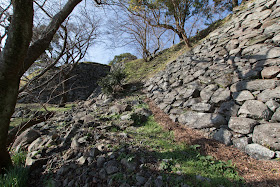

























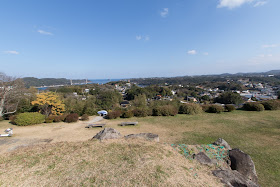















































































































































































































































































































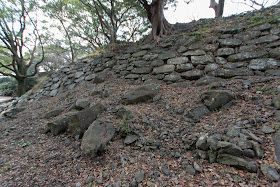

















































































































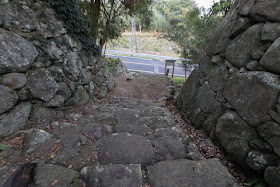

















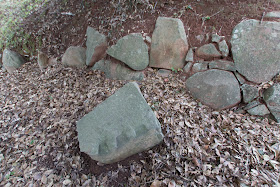










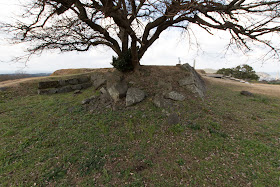













































No comments:
Post a Comment